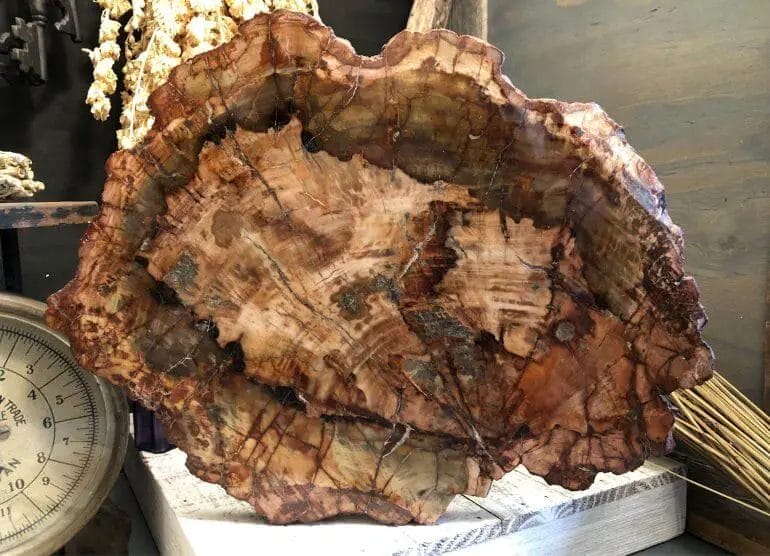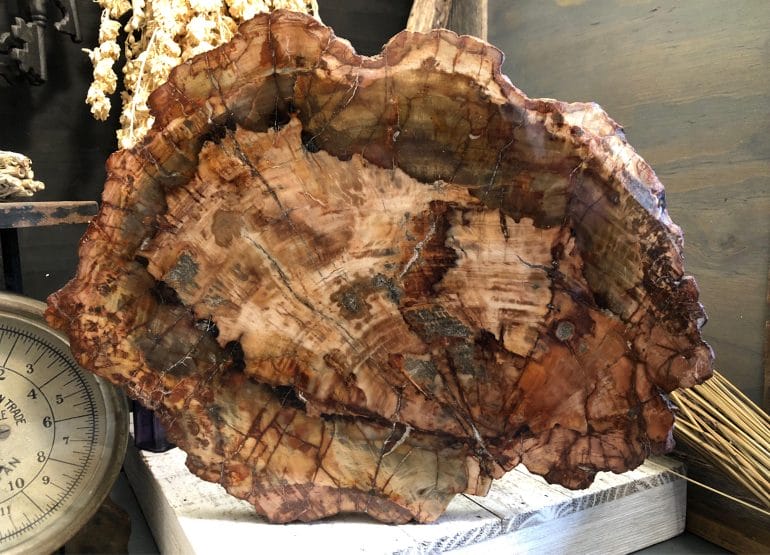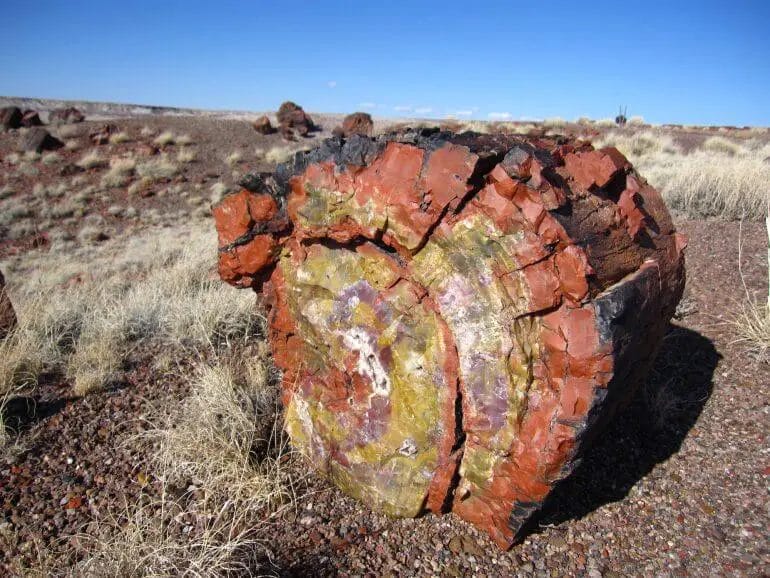Petrified wood is indeed a type of fossil that has undergone a remarkable transformation. This unique phenomenon occurs when trees are buried under layers of sediment and over millions of years, the organic material in the wood is replaced by minerals such as silica. As a result, the wood turns into stone, preserving the original structure and cellular details. Petrified wood not only showcases the beauty of nature but also offers valuable insights into ancient ecosystems and geological history.
The Fascinating Process of Petrification in Wood
Wood is a remarkable material that has been used by humans for thousands of years. It is versatile, durable, and abundant, making it an ideal resource for various applications. But have you ever wondered what happens when wood undergoes petrification? Petrification is a captivating natural process that transforms wood into stone over time. In this section, we will delve into the intricacies of this fascinating process.

Petrification, also known as fossilization, occurs when organic materials, such as wood, are replaced by minerals. The transformation takes place gradually, often over millions of years, as the wood is subjected to certain environmental conditions. The result is a remarkable preservation of the wood structure, with its organic components being replaced by minerals such as silica, calcium carbonate, or iron oxides.
One of the key factors in the petrification process is the presence of water. Water acts as a medium through which minerals can be transported and deposited within the wood cells. Over time, as water seeps into the wood, it carries dissolved minerals from the surrounding environment. These minerals are then precipitated and deposited within the cellular structure of the wood.
Another significant factor in petrification is the absence of oxygen. Oxygen can cause the decay and decomposition of organic matter, preventing the fossilization process. In environments where oxygen is limited, such as waterlogged or sediment-covered areas, wood has a higher chance of being preserved and petrified.
Once the minerals are deposited within the wood, they gradually replace the organic material while retaining the original structure of the wood cells. This process, known as mineralization, results in the petrified wood acquiring the hardness and durability of stone. The petrified wood maintains its original shape, texture, and even the intricate details of the growth rings, providing valuable insights into the ancient history of the wood.
The colors and patterns seen in petrified wood are determined by the specific minerals that have infiltrated the wood cells. For example, silica-rich solutions may create vibrant hues of red, orange, and yellow, while iron-rich solutions can produce shades of brown and black. These mineral impurities give each piece of petrified wood its unique and mesmerizing appearance.
Petrified wood is often found in regions with a rich geological history, such as ancient riverbeds, volcanic ash deposits, or sedimentary rock formations. These areas provide the ideal conditions for the preservation and petrification of wood over millions of years. Today, petrified wood is not only a scientific curiosity but also highly valued for its aesthetic appeal and used in jewelry, home decor, and artistic creations.
In summary, the process of petrification in wood is a captivating natural phenomenon that occurs over an extensive period. Water and the absence of oxygen play crucial roles in the preservation and substitution of organic material with minerals. The resulting petrified wood retains its original structure while acquiring the durability and beauty of stone. Its unique colors and patterns provide a glimpse into the ancient history of our planet, making petrified wood a truly fascinating natural treasure.

Unveiling the secrets of petrified wood: Composition and formation
Petrified wood is a fascinating natural phenomenon that has captivated the curiosity of scientists and enthusiasts alike. Through the process of petrifaction, organic wood material transforms into a mineralized form, preserving the intricate details of its original structure. In this section, we will delve into the composition and formation of petrified wood, uncovering the secrets behind this extraordinary process.
1. The Composition of Petrified Wood:
Petrified wood is primarily composed of silica, or silicon dioxide, which is one of the most abundant minerals on Earth. Silica infiltrates the cellular structure of the wood and gradually replaces the organic matter with minerals such as quartz, chalcedony, and opal. This mineralization process results in the preservation of the wood’s cellular structure and the creation of a colorful and durable fossil.
2. The Formation of Petrified Wood:
The formation of petrified wood begins with the burial of fallen trees or plant remains in sedimentary deposits such as riverbeds, floodplains, or volcanic ash. Over time, the wood is gradually submerged in layers of sediment, protecting it from decay and exposure to oxygen. The surrounding environment plays a crucial role in the fossilization process, influencing the colors and mineral content of the petrified wood.
As the wood becomes buried, groundwater rich in silica seeps into the cellular structure of the wood. The minerals in the water begin to crystallize and fill the empty spaces within the wood, resulting in the gradual transformation of organic material into stone. This process can take millions of years to complete, allowing for the intricate preservation of the wood’s original structure.
The colors present in petrified wood are a result of various mineral impurities and trace elements present in the surrounding environment during the fossilization process. Iron oxides, manganese, and carbonaceous deposits contribute to the vibrant hues and patterns seen in petrified wood specimens.
3. Factors Influencing Petrification:
Several factors influence the formation and quality of petrified wood. The type of wood and its cellular structure play a significant role in determining its petrifaction potential. Softwoods, such as pine, tend to petrify more readily compared to hardwoods due to their higher permeability and greater presence of resinous substances.
The presence of water-saturated sediments and mineral-rich groundwater is essential for the replacement of organic matter with minerals. The composition of groundwater, including its pH and mineral content, also affects the colors and patterns observed in the petrified wood.
Geological processes such as tectonic activity and volcanic eruptions can disrupt or enhance the fossilization process. These processes can introduce additional minerals and heat, accelerating the petrification process and influencing the final composition of the petrified wood.
In summary, the composition and formation of petrified wood are a result of intricate geological and biological processes over vast periods. The preservation of ancient wood material in a mineralized form offers a unique glimpse into the Earth’s history and provides valuable insights into the ancient ecosystems that once thrived on our planet. The beauty and scientific significance of petrified wood continue to inspire awe and fuel our exploration of the natural world.

Petrified wood as a valuable collector’s item: Rarity and worth
Petrified wood is not only a fascinating piece of natural history, but it is also highly valued by collectors around the world. Its unique formation process and stunning appearance make it a coveted item for those with an appreciation for geological wonders. In this section, we will explore the rarity and worth of petrified wood as a collector’s item.
Rarity of petrified wood
Petrified wood is formed through a process called mineralization, where organic materials such as trees or plants are gradually replaced by minerals over millions of years. This transformation occurs when fallen trees are buried under layers of sediment and are exposed to groundwater rich in minerals, which gradually seeps into the wood and replaces the organic matter.
Due to the specific conditions required for the formation of petrified wood, it is considered a rare occurrence. The process requires a combination of factors, including the presence of fallen trees, the right type of sediment for burial, and the availability of mineral-rich water. As a result, areas with a history of volcanic activity or ancient forests are more likely to have deposits of petrified wood.
Each piece of petrified wood is unique in its appearance and characteristics. The colors, patterns, and textures found in petrified wood are determined by the types of minerals present during the petrification process. This natural variation adds to the allure and value of each individual specimen.
Worth of petrified wood
The worth of petrified wood as a collector’s item can vary greatly depending on several factors. These factors include the rarity, size, quality, and aesthetic appeal of the specimen.
Rare and exceptional pieces of petrified wood, such as those with vibrant colors, intricate patterns, or unusual shapes, are highly sought after by collectors. These specimens can command high prices in the market due to their uniqueness and scarcity. Additionally, petrified wood from famous or remote locations may also have increased value due to its provenance.
The size of a petrified wood specimen also plays a role in its worth. Larger pieces are generally more valuable, as they are rarer to find and can be used for various purposes, such as display pieces or furniture. However, small and intricately detailed specimens can also be highly prized among collectors for their delicate beauty.
The quality of petrified wood is another important factor in determining its worth. High-quality specimens exhibit well-preserved cell structures, distinct mineralization patterns, and a polished surface. These characteristics enhance the visual appeal and scientific value of the specimen, making it more desirable to collectors.
In summary, petrified wood possesses both rarity and worth as a collector’s item. Its formation process and unique characteristics make it a highly sought-after natural wonder. Whether for its aesthetic beauty, scientific significance, or historical value, petrified wood continues to captivate collectors and enthusiasts alike.
Exploring the uses and applications of petrified wood in modern times
Petrified wood is a fascinating natural phenomenon that has captured the attention of scientists, collectors, and enthusiasts alike. This unique type of fossilized wood has been transformed into stone over millions of years through a process known as permineralization. While petrified wood has historical significance and is prized for its beauty, it also has practical uses and applications in modern times.
1. Decorative and ornamental purposes
Petrified wood is highly sought after for its aesthetic appeal. Its intricate patterns and vibrant colors make it a popular choice for decorative and ornamental purposes. Petrified wood can be used to create stunning countertops, tabletops, and tiles that add a touch of natural beauty to any space. It is also used in the creation of sculptures, jewelry, and other artistic creations.
2. Construction and architecture
Petrified wood has unique structural properties that make it a valuable material in the construction and architecture industry. Its durability and resistance to decay make it an ideal choice for outdoor applications such as decking, fencing, and landscaping. Petrified wood can withstand extreme weather conditions and can add a touch of natural elegance to any architectural design.
3. Geological research and education
Petrified wood plays a crucial role in geological research and education. Studying the composition and structure of petrified wood can provide valuable insights into the Earth’s history, climate, and evolution. It helps scientists understand ancient ecosystems, fossilization processes, and the preservation of plant life over millions of years. Petrified wood specimens are commonly used in classrooms and museums to educate students and the public about the Earth’s geological past.
4. Energy production
Petrified wood has the potential to be used as a source of energy. When burned, it releases heat and can be used as a substitute for traditional fossil fuels. However, the use of petrified wood for energy production is still in the experimental stage and requires further research and development to ensure its sustainability and efficiency.
5. Healing and metaphysical properties
In addition to its practical uses, petrified wood is believed to have healing and metaphysical properties. It is said to promote grounding, stability, and patience. Many people use petrified wood in various forms, such as crystals, for meditation, spiritual healing, and creating a sense of connection to the Earth.
In summary, petrified wood has a wide range of uses and applications in modern times. From its decorative and ornamental appeal to its usefulness in construction and architecture, petrified wood continues to captivate us with its rich history and timeless beauty. Whether it is used for geological research, energy production, or for its healing properties, petrified wood remains a valuable and versatile material in our contemporary world.
FAQs
Is petrified wood a fossil?
Yes, petrified wood is considered a fossil. It is formed when the original organic material of wood is replaced by minerals over time, turning it into stone. The process of petrification preserves the structure and cellular details of the wood, making it an important scientific and geological artifact.
Wrapping Up
In conclusion, petrified wood is indeed a fascinating and unique type of fossil. Through the process of petrification, organic matter is replaced by minerals, resulting in the preservation of the wood’s original structure. This remarkable transformation allows us to study and admire the intricate details of ancient trees that lived millions of years ago.
Furthermore, petrified wood serves as a valuable resource for scientists and collectors alike, providing insights into the Earth’s history and the plant life that once thrived. Its stunning appearance and durability also make it a popular choice for jewelry and decorative pieces.
So whether you’re an enthusiast of paleontology or simply appreciate the beauty of nature’s wonders, petrified wood is a captivating reminder of the Earth’s ancient past.